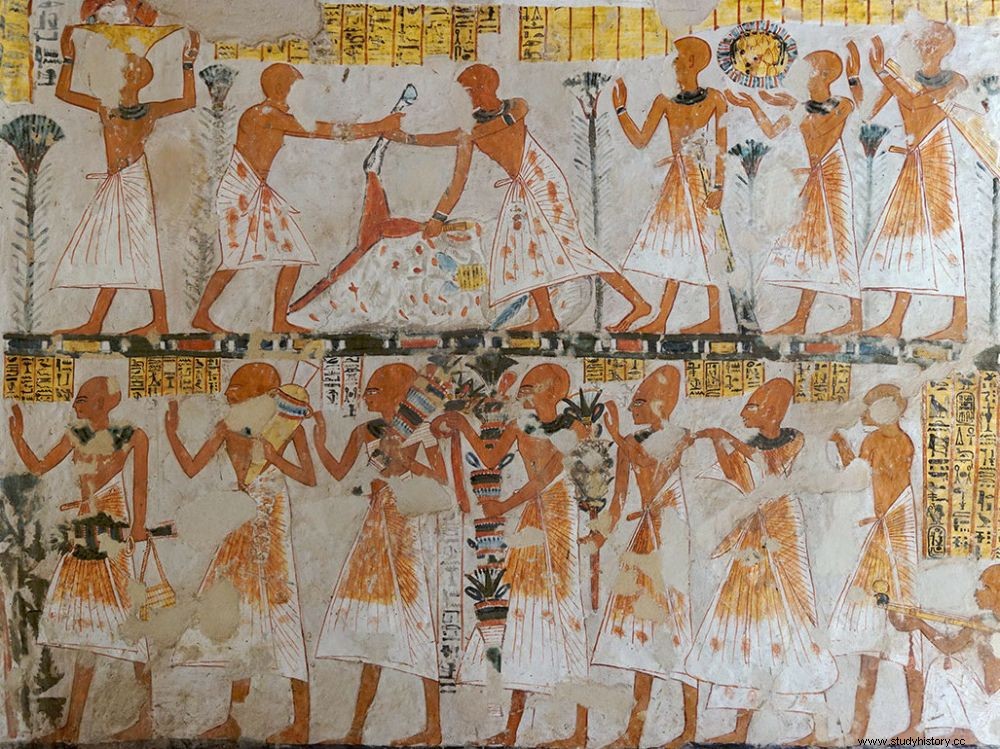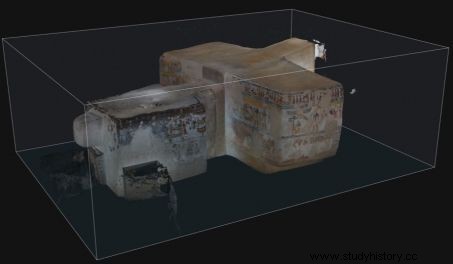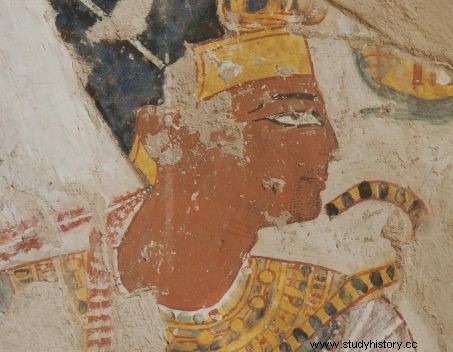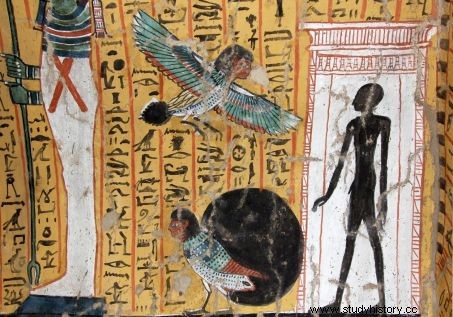For this 2nd episode of the Notebooks of Egypt, focus on the tomb of Nakhtamon, the one who was responsible for the composition of the altars at the Ramesseum and the order of the procession of the offering.

The procession of the offering:the head of the butchers of the Ramesseum is in the process of cutting, using a large knife, the leg of a bovid, while bearers of offerings move in procession towards the Pharaoh and a deity.
The burial chapel of Nakhtamon, discovered in 1925 in the Valley of the Nobles, Luxor, gives an idea of the ceremonials and reveals an astonishing painting of the face of Ramses II.
"Ancient and modern Egypt retains a rare exotic quality for the Western imagination"
Already Greco-Roman travelers and historians of their time have told us about a surprisingly religious people, almost obsessed with life beyond the grave, a people who did everything backwards. "Even today, setting foot on the tarmac of ultra-modern Luxor airport bathes us in the middle of winter with gentle breezes that make the palm trees sway. And it is not too rare to cross a camel aboard the old Peugeot, already fifty years old, but also more and more tropicalized, which takes us to our destination, the left bank, the crossing of the Nile being now facilitated by the presence of a bridge" , explains Philippe Martinez, Egyptologist at the Molecular and Structural Archeology Laboratory (Sorbonne University-CNRS).
But despite this bewitching context that would easily take us back a few centuries, it is very modern concerns that lead us to these Egyptian lands for the next three weeks. It is neither more nor less than deploying a whole arsenal of advanced digital techniques to try to understand how painters armed with reed brushes were able to decorate tombs using shimmering images that still make up all our admiration 3000 years later...
"Thousands of tombs are known and so little studied"
A few temples and above all thousands of tombs are grouped together along the course of the Nile in an uninterrupted series of necropolises linked to as many more or less important cities. The best known are those of Giza and Saqqara for the Old Kingdom (2700 to 2200 BC), and Thebes for the New Kingdom (1500 to 1000 BC). These ubiquitous necropolises seem to superficially confirm the impression of a people obsessed with death. But it would be nice to imagine the feeling that a visit to Paris would give us, if we only found the churches and the cemeteries there!
This vision is moreover doubly misleading:indeed, the monuments of eternity which are the only ones preserved, are linked to divinity, royalty or the members of an extremely tight elite, close to power. The most common necropolises, those of the "people", are yet to be discovered:the few known examples show tight groupings of simple holes in the ground where the deceased is accompanied only by rare food offerings. The Egyptians actually worshiped the life generated by the energy of a divine and benevolent sun. And only the wealthiest could afford to erect the monuments that fascinate us today.
“The chapels have been decorated with great care”
The buildings we have chosen to explore are known as "tombs of the nobles". They bring together both one or more sepulchral chambers, but also a place of worship which generally links a structured courtyard and a chapel. The latter, which is the most easily accessible space today, was often, for our greatest pleasure, decorated with care.
The chapels are often in the shape of an inverted T, with a wide room in front which undoubtedly corresponds to the reception area of the house of the dead. This space is decorated with scenes that are related to earthly life, what we often call "everyday life scenes". But, although they are teeming with anecdotal details linked to life here below, it is in fact a recomposed reality, perfect and out of time, participating in the creation of the cosmos at the heart of which the deceased wishes to spend his existence. The long space that follows it, on the other hand, is decorated with scenes more truly related to the ritualization of the deceased through his funeral and his active participation in the regenerated life of the afterlife.
The tomb is therefore the dwelling place of the deceased where each day a priest, paid by the funerary foundation linked to the tomb, comes to present offerings of which the regenerated dead will benefit from the essence while they will finally be physically consumed by the priest and his family.

3D view of the tomb of Nakhtamon. The tomb, dug in a rock of very poor quality, has a transverse room then a small passage which leads to an almost square room. © Insight Digital
"The representation of Ramses II is remarkable both from the point of view of iconography and that of pictorial practice"
Ramses II is represented in an original way, his chin covered with a growing beard, standing near the divinity Ptah-Sokar-Osiris. Each hair of the beard was made with a small touch of black paint. The color of the flesh differs when seen transparently through the linen garment or directly on the face. Its texture is then pasty and the traces of the brush are visible. Thick dots materialize the precious elements of the scepter and the necklace. We thus immediately see the pictorial technique used to achieve a striking representation.
Ms. Christiane Desroches-Noblecourt considered that the wearing of a beard represented here could correspond to a period of mourning, more precisely to the period between death and burial:on the day of the funeral, all those involved are shaved, mourning is finished. But what funeral was it?

Portrait of Ramses II in the tomb of Nakhtamon, © LAMS-MAFTO, CNRS
The life generated from beyond.
The conception that ancient Egypt had of the living being is that of a complex aggregate linking a series of parts into a whole:first comes the human body, a sort of biological machine serving as a support for the different essential elements of life. 'be. These bring together the name, the shadow, but also more exotic components such as the ba (intellectual energy), the ka (divine physical energy maintained by the vital essence of food) and an element that can only be revealed during a magical ritualization of the dead, the Akh. For the Egyptian, if death is a bad moment to pass, an enemy to be conquered by magic, a moment of disintegration of being, it is nevertheless possible to survive. But for that, the different components separated by death must be able to come together again, so that the deceased can "come out into the light of day". This is the reason why for those who can afford it economically, it is necessary to transform the corruptible body into an eternal statue through mummification. The necropolis is therefore literally a city of the dead where the deceased can enjoy strolling and interacting with the living. Even if some disgruntled departed come back to haunt them in the form of ghost spirits.

Shadow and Ba emerge from the Tomb of Irynefer (Deir-el-Medineh, Luxor, 19th dynasty) © LAMS-MAFTO, CNRS
Notebooks of Egypt, 1st episode:how did the painters of ancient Egypt work?
Notebooks from Egypt, 2nd episode:Discovering the funeral chapel of Nakhtamon.
Notebooks from Egypt, 3rd episode:The pigments of Egyptian painting.
Notebooks from Egypt, 4th episode:The modern documentation of painted walls.
Notebooks from Egypt, 5th episode:Rediscovering the monuments of eternity of Ramses II.
Notebooks from Egypt, 6th episode:Revealing pigments with light:the visible and the invisible.
Notebooks from Egypt, 7th episode:Experiencing research through images.
Notebooks of Egypt, 8th episode:Beginning of the study of the paintings of the tomb of Nebamon and Ipouky.
Notebooks from Egypt, 9th episode:A tomb shared by two artists under Amenhotep III.
Notebooks from Egypt, 10th episode:What the tomb of Amenouahsou, an artist from ancient Egypt, reveals.
Notebooks from Egypt, 11th episode:Strange uses that have been made of Egyptian mummies.
Notebooks from Egypt, 12th episode:"Why don't all the artists come here?"
Notebooks of Egypt, 13th episode:Why did the Egyptians draw the characters in profile?
Notebooks from Egypt, 14th episode:Observing craft practices in Egyptian tombs.
Notebooks from Egypt, 15th episode:About Egyptian perfumes.
Notebooks from Egypt, 16th episode:The colors of the Egyptian palette.
Notebooks of Egypt, 17th episode:The Egyptian language does not know a word to designate "art".
Notebooks of Egypt, 18th episode:The day of a scientific mission in Egypt.
